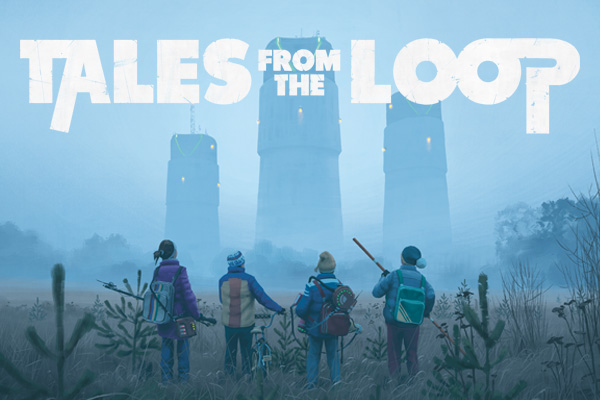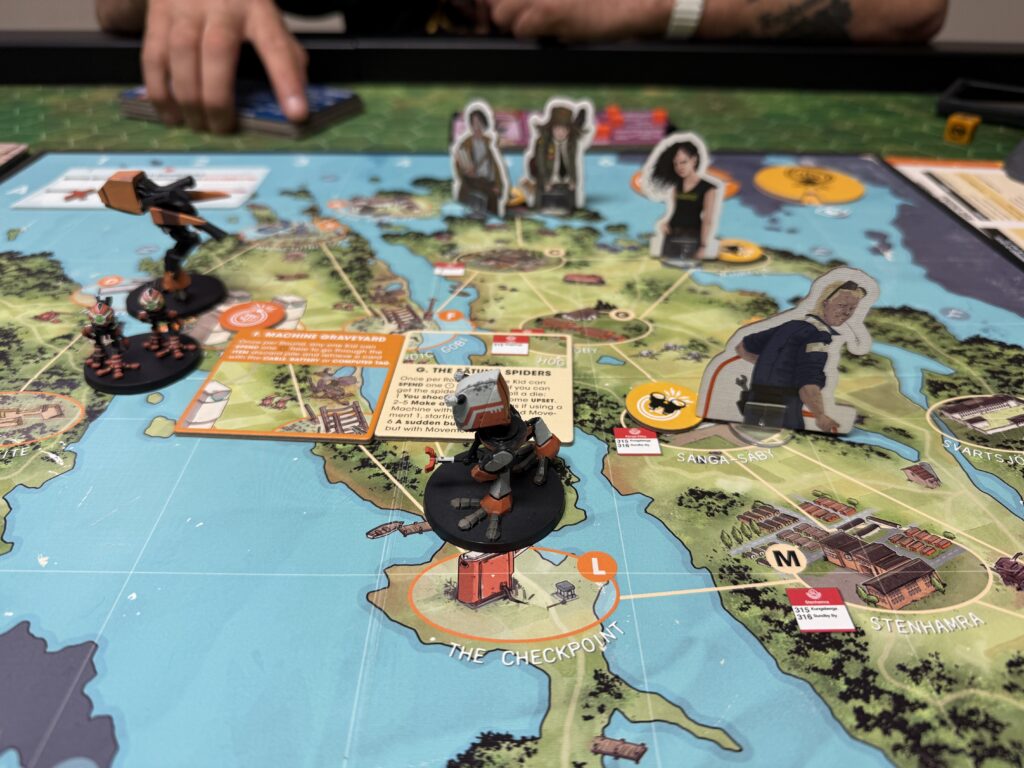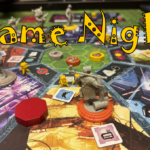Simon Stålenhag’s famous art combines scenes of utter banality with the fantastic — a robot in branded colors patrolling a field of wheat; a giant robot in ruins behind an old diner, and so on. Stålenhag’s book, “Tales from the Loop”, on which the game is based, connects his artwork through a fanciful tale of his upbringing in the area, telling the tale of the world’s largest particle accelerator — the Loop — through his eyes as a child.
In the board game, everyone takes on the role of one of these 80s kids and must balance school and chores with solving the mysteries surrounding the Loop. Each game runs through another scenario; a small deck of cards that outline the plot, dealing more cards or flipping cards as the kids succeed, fail or ignore the story. The story moves on even if the kids aren’t trying to solve that mystery; this will usually end badly.
Each game takes place over the course of two weeks. If the mystery isn’t solved in two weeks time, it’s game over. Each kid has a weekly chore to do (such as picking up your little sister from nursery school). Not finishing your chores gets you grounded by your parents. And you need them to want to drive you places, so, keeping on their good side by getting home for dinner each night is important. Each kid also has their personal item that can be combined with other items to form new items that can be used to instantly solve challenges. For instance, putting gum on the end of a hockey stick can pick up that weird device you noticed scurrying up and behind the bookcase.
Each round starts with the First Player token being passed to a new player. All players move simultaneously, but the First Player is the one that takes a School card each weekday and has to solve the challenge there — stand up to a bully, get lost on a field trip and so on. Kids in the same location can optionally help you complete the challenge, and share the punishment if it fails.
Each round, a number of “Rumor” cards are played onto the board. Any old Rumor cards are discarded, paid for by raising the Enigma value. Enigma is the likelihood of bad stuff happening on the main plot scenario. Its counterpart, Insight, is raised by clearing rumors.
Each Rumor is a single card scenario that requires a combo — like the “gum + hockey stick” to clear — or passing a skill challenge which, again, can be shared with people in your area. They can only be cleared by moving to that area and performing the task. Clearing it often results in an item that can be used to make more combo items to clear challenges.
The dice are the real enemy in this game. Challenges are cleared by rolling a number of dice that depends on who is helping and your strengths and weaknesses. If any of them show a six — you succeed, otherwise you fail. We’d be rolling three dice, four dice, five dice at a time and no sixes. We were having to take on crippling conditions — exhaustion, scared, injured, upset — until we made a house rule that, to succeed challenges, at least one die must show a five OR a six. We still had failures, but were able to get on with the game.
Everything a kid does costs time cubes. You get six on a weekday and nine for the weekend. Time cubes can be spent on bus rides, clearing rumors and advancing the plot. They can be taken (temporarily) out of play by having negative conditions.
The robots are a constant, silence presence in the game, moving around on their own ends unless forced to by a story card or by being hacked by a kid. If they become alerted, they may decide to seek out the source of their irritation — probably you. Hacking a robot is a difficult chore; we haven’t managed to do it even once.
Tales from the Loop isn’t as meditative as the source material suggests. There’s always the time pressure — going to school, going home, working on the chores, working to clear rumors, working to advance the storyline — that means you’ll often not have enough “time cubes” to use for the things you must complete. The randomness underlying every rumor, chore, schoolwork and plot makes it hard to budget your time, leaving you exhausted or upset and perhaps having to spend the night in a field, far from home. Each game session is a little slice of these kids’ lives. Time continues without you and there’s always chores to be done.
We’ll play another scenario or two, but I don’t think we’ll play through all the scenarios that came with the base game, much less the expansion scenarios. The game avoids the thrilling boss fights and immediacy of usual board games to focus on the mundanity of an 80s kids life who just happens to be surrounded by hints of the fantastic.






